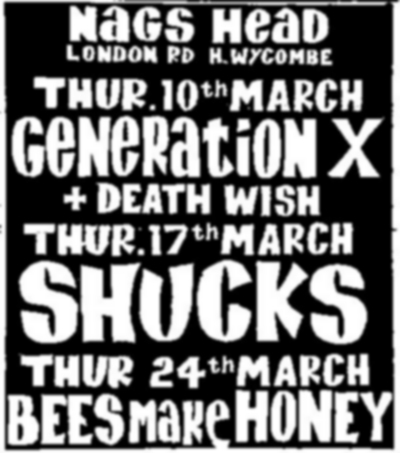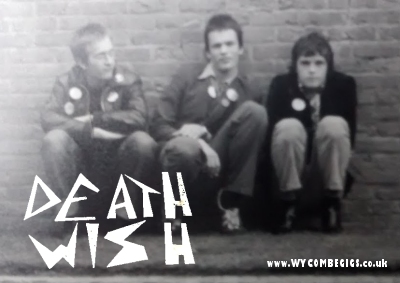Thursday 10th March 1977 – Generation X/Deathwish – Nag’s Head
Generation X make their second appearance at The Nag’s Head ahead of signing a record deal. Support comes from Deathwish, the only locally based ‘punk’ band at the time.

The day of the gig coincided with the day The Sex Pistols pulled the publicity stunt of signing their new record deal with A&M records outside Buckingham Palace. The group arrived at 9am, jumped out their car for the waiting media shots, and were then on their way back to Regent Palace Hotel for a press conference. The signing-on fee is reported to be worth £150,000. Less than a week later they were sacked following a culmination of various incidents, including an altercation with BBC’s Bob Harris.
Deathwish consisted of Kris Jozajtis (guitar and vocals), Carlton Mounsher (bass) and Mark White (drums) who had formed the band during the heatwave summer of 1976. The trio had then seen The Sex Pistols at the September 1976 gig at The Nag’s Head and the ‘year zero’ moment for the punk scene in High Wycombe was set. Deathwish debuted at a chaotic gig at Liston Hall, Marlow on 30th October 1976 before gigs at High Wycombe’s Desborough Hall, Nag’s Head and SU Bar before the end of 1976. They too were mostly chaotic.

Also associated with Deathwish at the time was 16 year old roadie Dylan Jones – a former pupil at Great Marlow Secondary School. He later attended Chelsea Art School and then Saint Martin’s School of Art in London, before a career in journalism, including time with i-D, Arena, The Face, and culminating as editor of GQ magazine in 1999. He was awarded the OBE in 2013 for services to the publishing and British fashion industries.
In an article published on The Daily Mail online in April 2009, Jones recalls his time back in 1977 High Wycombe.
“We supported Generation X at the town’s infamous punk venue the Nag’s Head, and the excitement convinced me to take to the stage again. And having experimented with various (awful) punk groups (the Un, for instance, and a white reggae motorcycle band called – I kid you not – Bob Harley), I finally joined a British version of the B-52’s, 18 months before the B-52’s actually existed, who played Motown covers, primeval ska and a selection of ‘original’ material (most of which sounded like punked-up Motown B-sides).”
The band were called The Dads – they never quite made it and Jones eventually went down the journalism route.
For Deathwish, their support slot for Generation X was to be their last gig before re-incarnating as The Pretty in the summer of 1977. Deathwish songs at the time included: ‘Destruction’, ‘Ballad of The Blank Generation’, ‘AD 2001’, ‘Pain’, ‘Domestic Nightmares’ and ‘You’re So Keen’.
Meanwhile, headliners Generation X were returning to High Wycombe having first played in January 1977 (their 9th ever gig and the first outside London). The March 1977 appearance was still only their 16th ever gig for a band still finding their feet but also just starting to attract the attention of record companies.
Photos of the Nag’s Head gig have been posted to the excellent Generation X Facebook page but they can be difficult to find, so I have posted one below:

The Nag’s Head appearance goes off without too much fuss but their appearance the following night at University of Leicester, at the Clare Hall Easter Ball, is marred by an ever growing problem at the time. Halfway through the set, guitarist Bob ‘Derwood’ Andrews is hit in the head with a full can of beer. The show is stopped so that Derwood can be taken to the hospital for stitches. The troublemakers are reported in the music press as ‘Led Zeppelin’ heavies – the growing phenomena being violence between rivals ‘tribes’ of music followers, with the young ‘punks’ generally being the ‘easy’ targets .
There is also some 1977 live footage of Generation X available on YouTube.
Both clips will give you idea of the energy on stage at The Nag’s Head back in March 1977
First clip from Don Letts’ Punk Rock Movie
Second clip, later in the 1977 from The Marquee
Generation X would return to The Nag’s Head twice more in 1977 – each time the queues to get in would get longer as the ‘punk’ scene in High Wycombe began to take off.